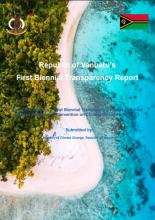Republic of Vanuatu’s First Biennial Transparency Report
Republic of Vanuatu’s First Biennial Transparency Report (FBTR)Under the Vanuatu’s First Biennial Transparency Report to United Nations Framework Convention on Climate Change (UNFCCC)Submitted by: Ministry of Climate Change, Republic of VanuatuExecutive summary This inaugural Biennial Transparency Report for Vanuatu serves as a comprehensive overview of the nation’s efforts to meet its commitments under the Paris Agreement. It encompasses critical aspects of Vanuatu’s national circumstances, greenhouse gas (GHG) inventory, progress tracking for nationally determined contributions (NDCs), climate change impacts and adaptation strategies, as well as financial and technological support needs and responses related to climate change. Additionally, the report addresses initiatives aimed at averting, minimizing, and addressing loss and damage associated with climate change impacts.I. National Circumstances and Institutional ArrangementsVanuatu’s unique geographical and socio-economic context is characterized by its status as a small island developing state (SIDS), facing significant vulnerabilities due to climate change. This section outlines the institutional frameworks in place to facilitate climate governance, including coordination mechanisms among government agencies, civil society, and local communities. The report emphasizes Vanuatu's commitment to integrating climate action into national development plans, promoting resilience, and ensuring sustainable development.II. National Greenhouse Gas InventoryThe national GHG inventory provides a detailed assessment of emissions sources across key sectors, including energy, agriculture, and waste management. It highlights the challenges of data collection in a small island context while showcasing efforts to improve accuracy and comprehensiveness. The inventory serves as a baseline for Vanuatu’s GHG emissions, essential for tracking progress and informing future climate policies.III. Progress on Nationally Determined ContributionsThis chapter outlines Vanuatu’s NDCs, focusing on renewable energy targets, emission reduction goals, and climate resilience initiatives. The report presents progress made towards these targets, including capacity-building measures, stakeholder engagement, and policy implementation. It identifies barriers faced in achieving NDCs and outlines strategies for overcoming these challenges.IV. Climate Change Impacts and AdaptationVanuatu is experiencing a range of climate change impacts, including sea-level rise, extreme weather events, and biodiversity loss. This section discusses the nation’s vulnerability assessments and adaptation strategies, including community-based adaptation practices and infrastructure resilience initiatives. The report emphasizes the need for ongoing investment in adaptive capacity to mitigate the adverse effects of climate change.V. Financial, Technology Development, and Capacity-Building SupportVanuatu’s financial and technological needs for climate action are critical to achieving its climate goals. This chapter assesses the support received under international frameworks and outlines the gaps in funding and technology transfer necessary for effective climate action. It emphasizes the importance of strengthening partnerships and securing resources to enhance the nation’s capacity to respond to climate change.VI. Averting, Minimizing, and Addressing Loss and DamageThe report examines Vanuatu’s approach to loss and damage associated with climate change impacts, including strategies for risk reduction and recovery from climate-related disasters. This section highlights the importance of integrating loss and damage considerations into national planning and emphasizes the need for international cooperation and support to address these challenges effectively.In summary, Vanuatu’s First Biennial Transparency Report reflects the nation’s commitment to transparency and accountability in its climate actions. It underscores the interlinkages between sustainable development, adaptation, and mitigation, and highlights the critical need for continued support from the international community to achieve the nation’s climate goals effectively.
Files
Document Tabs

